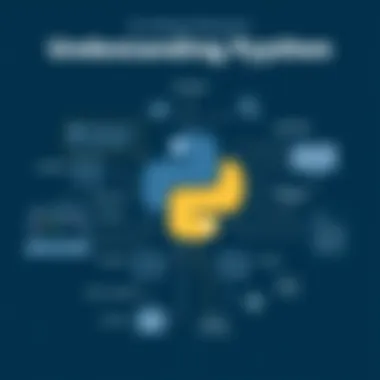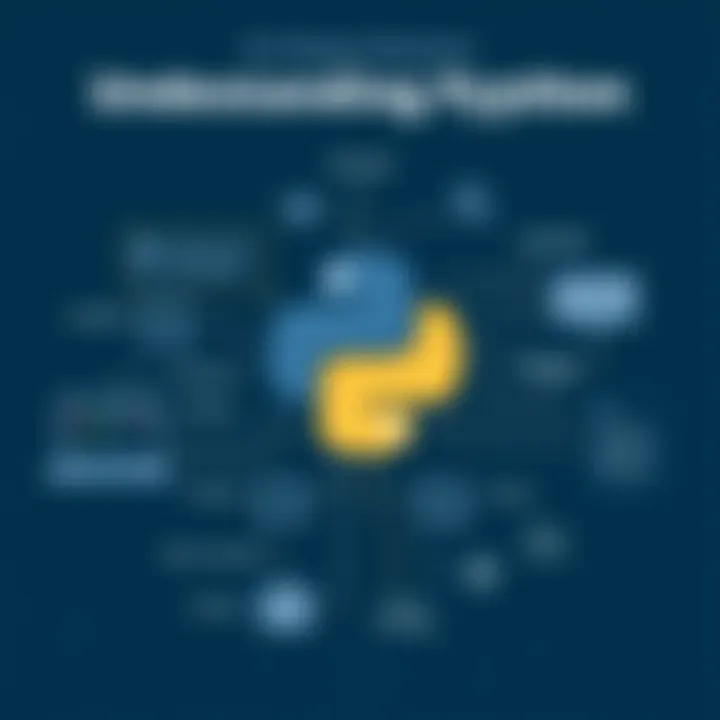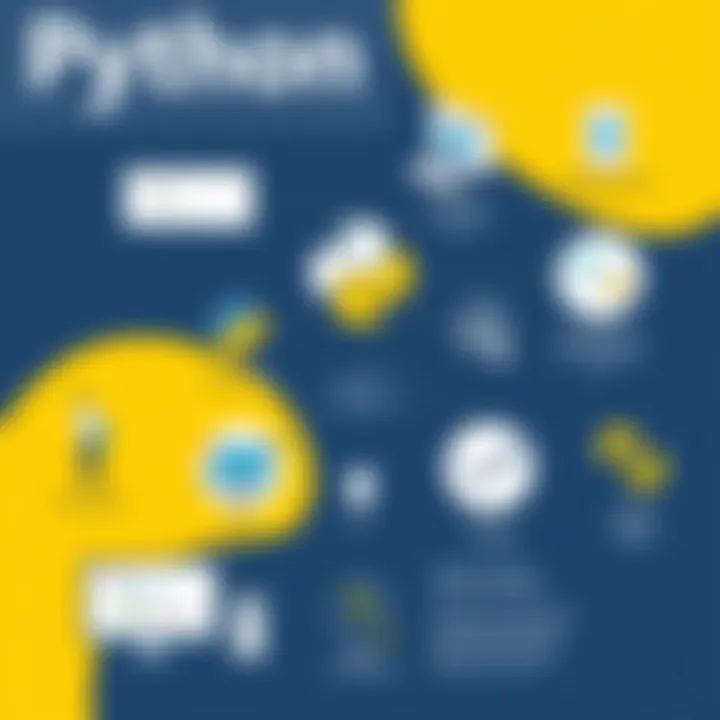Exploring the Phyton Universe: Comprehensive Analysis


Intro
The world of programming is bustling with languages, each designed to tackle unique challenges. Among them, Phyton has emerged as a robust contender, making waves across numerous sectors, from software development to data science. It's not just another tool in the toolbox; it's a versatile companion that programmers and IT professionals have embraced wholeheartedly. But what sets Phyton apart?
With its clean syntax and vast library ecosystem, Phyton enables developers to accomplish a lot with less boilerplate code. The language's light footprint belies its powerful capabilities, which have made it a favorite for cloud computing solutions, analyzing data, and even dabbling in machine learning.
Exploring how Phyton fits into the broader landscape of technology offers deep insights into its current and future relevance. As we navigate through this article, let’s delve into its significance in various domains, shedding light on best practices, real-world applications, and the ever-evolving trends shaping its journey.
Prologue to Phyton
In today’s rapidly evolving technological landscape, the significance of understanding programming languages cannot be understated. Phyton has emerged as a leading force among these languages, captivating professionals and enthusiasts alike with its versatility and practicality. While it might be tempting to dismiss it as just another programming language, delving into the depths of Phyton reveals a rich tapestry of features and benefits that make it indispensable in various fields. This section aims to lay the groundwork for why Phyton matters and how it’s reshaping the coding world.
History and Evolution
Phyton’s journey started in the late 1980s, a time when programmers were yearning for a language that combined readability and efficiency. Created by Guido van Rossum, Phyton debuted as a successor to the ABC programming language. The design philosophy emphasized simplicity and elegance, appealing to both novice programmers and seasoned experts.
Over the years, the language has evolved significantly, with major releases bringing in new features and enhancements. Phyton 2, released in 2000, expanded its libraries and introduced a more robust framework. However, it was the launch of Phyton 3 in 2008 that marked a pivotal moment in its evolution. While some older projects initially resisted migration, the introduction of Unicode support and several syntactic improvements gradually persuaded the community to embrace the newer version. The development and expansion of a vast array of libraries contributed to Phyton's burgeoning popularity, making it a staple in data analysis, web development, and automation.
Key Features of Phyton
Phyton possesses several standout features that contribute to its esteemed status in the programming community. Here are a few that deserve special mention:
- Clear Syntax: Phyton’s syntax is designed to be intuitive. Unlike languages that utilize complex symbols and rules, Phyton resembles natural language. This strongly lowers the barrier to entry for newcomers.
- Rich Libraries: The extensive collection of libraries offers tools and functions that facilitate everything from web scraping to machine learning. Libraries like Pandas for data manipulation and NumPy for numerical operations empower developers to tackle various challenges without reinventing the wheel.
- Portability: With its cross-platform capability, code written in Phyton can often run on different operating systems without requiring any modifications. This feature is especially beneficial for teams working in diverse environments.
- Community Support: The Phyton community is vast and vibrant. Resources, tutorials, and forums abound, making it easy for developers to find help and share knowledge. This communal spirit supports continuous improvements and innovations in the language.
- Versatile Applications: Phyton is not just restricted to one niche; it finds use in web development, data science, automation, game development, and much more. Such versatility ensures it remains relevant in multiple domains.
To sum up, an understanding of Phyton's history and key features sets the stage for comprehending its current role in the tech ecosystem. As the next sections unfold, we will delve deeper into Phyton's syntax and libraries, ultimately showcasing its widespread applicability and significance.
Understanding Phyton Syntax
Understanding Phyton syntax is akin to learning the essential vocabulary of a new language; it forms the backbone of effective programming and facilitates seamless communication between the coder and the machine. The significance of mastering syntax cannot be overstated, as it shapes how algorithms are structured and how data flows within programs. Grip the nuances of this syntax, and you unlock the door to creating robust applications that meet real-world needs.
When diving into Phyton, it's important to recognize that its elegant syntax sets it apart from other programming languages. Rather than a clutter of punctuation and symbols, Phyton emphasizes readability and simplicity. This design choice not only makes writing code less taxing but also enhances maintainability. In environments where collaboration is key, a tidy codebase fosters understanding and cooperation among team members. Plus, it’s easier on the eyes.
Basic Constructs
At the core of Phyton syntax are the basic constructs that make up its building blocks. These include variables, comments, and functions, which offer the foundational tools required for any programmer.
- Variables are like containers that hold data, and naming them affordably is vital. A good practice is whipping up variable names that are descriptive, for example, makes immediate sense compared to a generic .
- Comments provide clarity. By simply using the symbol, you can articulate your thoughts, making the code easier to follow when revisited later. A well-placed comment can save hours of confusion.
- Functions segment code into manageable chunks, allowing for modular design. They’re essential for eliminating redundancy and enhancing readability in larger programs. Here’s a simple function in Phyton:
python def calculate_tax(price): return price * 0.15
- Loops: These allow for repeated execution of a block of code. Two popular types are loops and loops. For instance, a loop can iterate through a list:
Each control structure serves a unique purpose, guiding how data is manipulated and results produced.
Data Structures
Lastly, data structures in Phyton provide efficient ways to organize, manage, and access data. Different types of data structures — like lists, dictionaries, and sets — are useful for various tasks.


- Lists are ordered collections of items. You might picture them as lined-up boxes:
- Dictionaries, meanwhile, are akin to reference books, allowing you to store key-value pairs:
- Sets are like clubs where each member is unique. They allow for set operations without duplicates.
Understanding these structures not only aids in data organization but also influences performance and efficiency during execution.
Phyton Libraries and Frameworks
The strength of Phyton lies not solely in its core syntax and structure but also in its extensive libraries and frameworks. These tools act as powerful allies for developers, simplifying complex tasks, enhancing productivity, and providing a wealth of resources tailored for various applications. The use of libraries enables practitioners to harness existing code, making the development process more efficient and allowing them to focus on creating unique solutions rather than reinventing the wheel. Consequently, understanding these libraries and frameworks can be the difference between a mediocre project and a stellar one.
Numerical and Scientific Libraries
NumPy
NumPy serves as the backbone for numerical computations in Phyton. One of its standout features is its powerful N-dimensional array object, which makes handling large datasets a walk in the park. By enabling fast and efficient array operations, NumPy allows users to perform complex mathematical functions without breaking a sweat. Its ability to operate on large arrays and matrices is crucial for applications in science and engineering.
A key characteristic of NumPy is its compatibility with a wide range of Phyton libraries, making it an essential component in any data-centric project. However, one must be cautious about memory usage, as large datasets can lead to performance bottlenecks if not managed properly. Thus, while its speed and efficiency are undeniable, developers must maintain a vigilant approach to resource management.
SciPy
On the other hand, SciPy complements NumPy by providing additional functionality for scientific computing. It's particularly noted for its capabilities in optimization, integration, and statistics. When you have a problem that requires highly-specialized routines, SciPy steps in to save the day.
One key feature of SciPy is its exponential growth in scientific disciplines, allowing researchers to utilize sophisticated algorithms without needing a deep understanding of their inner workings. However, like NumPy, the complexity of its functions can prove daunting for beginners. Therefore, while SciPy is beneficial for advanced users, those new to Phyton might find its learning curve a bit challenging.
Data Analysis and Visualization Tools
Pandas
Entering the realm of data analysis, Pandas is often hailed as the ultimate tool. With its DataFrame structure, which is akin to a table in a database, Pandas allows developers to manipulate and analyze data seamlessly. Whether you are filtering, grouping, or aggregating data, the ease of use that comes with Pandas can make a data analyst’s life significantly easier.
Its key strength lies in its ability to handle missing data, which is often a common issue in real-world datasets. Still, while it is robust, poor performance in extreme scenarios can be a downside to consider. At the end of the day, it's a foundational tool for anyone delving into data science.
Matplotlib
When it comes to data visualization, Matplotlib shines brightly. This library enables users to create static, animated, and interactive plots in a straightforward manner. It provides a low-level interface for creating graphs, making it suitable for those who want complete control over aesthetics and layout.
However, while Matplotlib is highly customizable, its learning curve can be steep for beginners simply looking to create quick visualizations. Users often find themselves wading through quite a bit of documentation to achieve complex visualizations, but the results can be worth it. Great for making representations that are publication-ready, but it does demand a time investment.
Seaborn
Seaborn builds upon the capabilities of Matplotlib, introducing a more user-friendly interface for statistical graphics. It simplifies many tasks while still incorporating the powerful underlying framework. Its key characteristic is its ability to create attractive and informative statistical graphics with minimal code.
One unique aspect of Seaborn is its integration with Pandas data structures, which allows for quick analysis and visualization comparisons. The balance here is that while it does allow for rapid development of visualizations, it may not always accommodate specific customizations that more advanced users might desire. Still, it has become a go-to for quick, visual data storytelling.
Machine Learning Libraries
Scikit-learn


As the king of machine learning libraries in the Phyton ecosystem, Scikit-learn brings a wealth of algorithms under its belt for tasks ranging from classification to regression and clustering. Its ease of use and documentation make it accessible for newcomers and veterans alike. Users can get models up and running in no time.
One of the significant features is that it promotes best practices through tools for cross-validation and model evaluation. However, it can struggle with larger datasets; therefore, scalability must be a consideration when choosing it for big data projects.
TensorFlow
TensorFlow has made waves for its versatility and robustness in building complex machine learning models. One prime advantage is its excellent scalability, allowing applications to traverse from a single CPU to a cluster of GPUs effortlessly, which can be vital in resource-heavy applications.
However, its flexibility often comes at the cost of increased complexity. Beginners might find it to be a bit of a labyrinth, with intricate configuration needed to get started. That said, it’s a powerhouse for anyone serious about deep learning.
Keras
For those who want to dive into neural networks without the hassle of TensorFlow's intricacies, Keras is the answer. It’s widely regarded for its user-friendly API and modularity, making it ideal for rapid experimentation. Users can build and train models quickly with less boilerplate code.
One potential drawback is that while it abstracts away complexity, it also limits low-level customization, which can frustrate advanced users looking to experiment with model architectures. Yet, for many projects, Keras serves as an excellent entry point into the realm of deep learning.
Libraries and frameworks in Phyton are essential facets that empower developers. They are the tools in the toolbox that can elevate a simple script into a comprehensive solution.
Applications of Phyton
The applications of Phyton are vast and varied, making it a vital programming language in today's tech landscape. Whether it’s for web development, data analysis, or integrating with cloud services, Phyton's versatility shines through. The ability to use the same language across multiple domains reduces the learning curve for developers and enhances productivity. This section dives into three key areas: web development, data science, and cloud computing integration, showcasing the significance of Phyton's role in each.
Web Development
Django
Django stands out as a powerful web framework that allows developers to create high-quality web applications rapidly. One of the most noteworthy aspects of Django is its **
Best Practices in Phyton Development
The realm of Phyton development is as vast and varied as the starry skies. But just like navigating a ship through treacherous waters, having a solid grasp of best practices in Phyton can help steer developers clear of common pitfalls. In this section, we will dissect the significance of these practices, focusing on elements like writing efficient code, debugging methods, and version control—all of which are essential for enhancing productivity and maintaining high-quality outputs.
Writing Efficient Code
Efficient code is akin to a well-oiled machine. It runs smoothly, conserves resources, and yields better performance. Writing efficient code in Phyton isn't solely about speed; it also involves clarity and maintainability. Developers must consider computational complexity and memory usage while ensuring that the code remains readable by others.
Here are a few pointers to keep in mind:
- Utilize built-in functions: Phyton boasts a library of built-in functions optimized for performance. Why reinvent the wheel when you can leverage functions like , , and ? They enhance readability while boosting execution speed.
- List comprehensions: When tasked with constructing lists, using comprehensions can cut down on lines of code and improve runtime performance compared to traditional loops, making your intentions crystal clear.
- Avoid global variables: While they might seem convenient, global variables can usher in complicated bugs. Keep variables local for easier manageability and to minimize side effects.
Being effective in your coding principles not only reduces redundancy but also saves time in debugging and future alterations.
Debugging and Testing Methods
Debugging can feel like searching for a needle in a haystack—frustrating and time-consuming. However, implementing robust debugging and testing strategies is vital to ensure that your application runs as intended.
- Use built-in debugging tools: Phyton offers the module, which allows step-by-step execution of code. Familiarize yourself with this tool; it can be a lifesaver.
- Write unit tests: Adopting test frameworks like or can preemptively catch bugs before they make it to production. A small investment in testing can provide substantial returns by preventing costly fixes later.
- Employ logging: Instead of using print statements to trace issues, make use of the library. It enables flexible output levels and can be tuned to show only what you need.
Debugging is not just about fixing issues but understanding them. By recording and analyzing errors, developers can improve future workflows.
Version Control and Collaboration
No man's an island, especially in software development. Version control and collaboration practices ensure that teams can work harmoniously, akin to musicians playing in a well-coordinated orchestra.


- Use Git: Familiarity with Git is non-negotiable. Even if you’re working solo, using Git for version control allows you to track changes and revert to earlier states if necessary. Establish a habit of committing often with clear messages.
- Branching: When working on new features or bug fixes, create branches. It keeps the main codebase stable while you experiment. This practice not only allows safe iterations but also simplifies future merging.
- Collaboration tools: Platforms like GitHub or Bitbucket make it easier to collaborate on projects, enabling code reviews and discussions that nurture better coding practices.
Involving others in your process and using effective collaboration tools can lead to innovative solutions and optimized codes.
Effective practices in Phyton development are not just recommendations; they are essences shared by seasoned developers over time. Ignoring them can lead to unnecessary headaches, while embracing them sets projects up for success.
By adhering to these practices, Phyton developers can harness the power of the language, crafting cleaner, more efficient, and easily maintainable code. As the tech landscape continues to evolve, staying abreast of these best practices is imperative for any developer aiming to make a significant impact in their field.
For further reading on code performance and debugging strategies, you may refer to resources such as Wikipedia on Phyton Programming and articles on Stack Overflow for community-driven insights.
Challenges and Limitations of Phyton
When discussing any programming language, it is crucial to examine its challenges and limitations. Phyton, while being a robust and versatile tool in the realm of software development, is not without its drawbacks. Understanding these challenges helps developers make informed decisions about when and how to employ Phyton effectively in their projects. This section provides insights into two primary issues: performance and concurrency, which often influence the usability and efficiency of Phyton in real-world applications.
Performance Issues
One of the most talked-about aspects of Phyton is its performance relative to other programming languages. When you dive deep into the details, it becomes clear that Phyton is an interpreted language, which means it generally runs slower than compiled languages such as C or C++. This can become a stickler in scenarios that require high-speed operations or computationally heavy tasks.
- Interpreted Nature: The fact that Phyton executes code line by line contributes to slower execution times, especially in programs that require numerous iterations or extensive data processing.
- Memory Usage: Phyton's memory consumption is often higher compared to languages like Java or Go. This can make it less suitable for applications where memory efficiency is paramount.
- Optimization Limitations: While dynamic typing and flexibility are key strengths of Phyton, they can also make it harder to optimize performance. For example, certain operations might not take full advantage of the underlying hardware capabilities.
As the saying goes, “a chain is only as strong as its weakest link,” and in the case of Phyton, performance can be that weak link if not handled with care.
"Understanding the limitations of Phyton is as important as mastering its strengths; it’s all about finding the right tool for the right job."
Concurrency and Parallelism
Concurrency and parallelism are two essential aspects in modern computing that allow programs to execute multiple tasks simultaneously, thereby enhancing overall performance. Phyton’s Global Interpreter Lock (GIL) creates a unique challenge in this area.
- Global Interpreter Lock: The GIL prevents multiple native threads from executing Python bytecodes at once. As a result, even on multi-core processors, Phyton performs like a single-threaded application in most situations. This makes it less effective for CPU-bound tasks that could benefit from parallel execution.
- Workarounds: Developers often have to employ workarounds, like using multiprocessor libraries (such as ) or switching to other languages when they need heavy lifting done in a multi-threaded manner. Although these solutions can work, they typically add complexity to the codebase.
- Suitability for I/O Operations: However, it’s noteworthy that Phyton shines in I/O-bound applications. Libraries like enable developers to handle asynchronous code efficiently. This means while Phyton isn’t the panacea for all performance problems, it is quite capable in certain contexts.
In summary, navigating Phyton's limitations requires a balanced understanding of both the challenges and practical workarounds. As those in the know often say, you can't have a more glorious sunset without having a few clouds in the sky. Thus, while Phyton poses some hurdles, it is still a formidable language when used wisely.
For additional information on these topics, you may refer to:
- Performance Considerations in Python
- Concurrency in Python
- Understanding Python's GIL
- Stack Overflow Discussions on Python Performance
This deeper dive into Phyton’s challenges illustrates the importance of not just knowing one’s tools but understanding their limitations. Navigating these intricacies can lead to more efficient, effective, and ultimately rewarding coding experiences.
Future Trends in Phyton
As technology leaps forward, programming languages must evolve to keep pace with changing demands and emerging technologies. Phyton, known for its versatility and simplicity, is no exception. Understanding the future trends within this realm not only prepares developers but also ensures they stay ahead of the curve in an ever-competitive landscape.
Emerging Technologies
In the realm of programming, the evolution of technologies influences the way languages adapt. Phyton’s integration into maturing fields such as artificial intelligence, machine learning, and data science underscores its adaptability to emerging technologies.
- Artificial Intelligence (AI): Phyton continues to be a leading choice for AI development. Frameworks like TensorFlow and PyTorch have carved niches in deep learning, encouraging innovations in neural network design. The growth of AI applications positions Phyton firmly at the forefront of this technological revolution.
- Blockchain: As businesses explore decentralized applications, Phyton’s clarity and ease of use make it a candidate for blockchain development. Libraries like web3.py allow developers to interact with Ethereum-based applications, facilitating smart contract deployment and interaction.
- Quantum Computing: Although still in infancy, quantum computing stands to transform computing as we know it. Phyton is already embraced in this field, with libraries like Qiskit paving the way for quantum programming. Developers can leverage familiar syntax to start experimenting with quantum algorithms.
The ability of Phyton to integrate seamlessly with these emerging areas signals not only its relevance but also its potential to shape the foundation of future technological advancements. However, developers must remain cognizant of the learning curve associated with these new technologies and pursue continuous learning to stay proficient.
To remain competitive, staying updated on emerging technologies and their integration into Phyton is crucial for developers and organizations alike.
Community Evolution and Contributions
The Phyton community is dynamic and ever-evolving, reflecting the collective efforts of its members to push the boundaries of what's possible. The strength of this community lies not merely in its size but also in its diversity of knowledge and experience.
- Open Source Contributions: Many Phyton libraries are open source, enabling developers to contribute their enhancements and fixes. This collaborative spirit fosters innovation and accelerates development processes.
- Educational Resources: Organizations and users within the Phyton community actively share educational resources. Platforms like PyCon and online forums have become hubs where knowledge is freely exchanged. Enthusiasts regularly engage in teaching, mentoring, and organizing hackathons to disseminate information and skills.
- Diversity Initiatives: The community is working on initiatives to enhance inclusivity. Through programs targeting underrepresented groups in tech, Phyton aims to broaden participation and bring fresh perspectives to the programming table.
Understanding the evolution of the Phyton community and the contributions made by its members is essential for developers. Engaging with this vibrant community not only aids personal growth but also helps foster the language’s continuous evolution. By mindful participation, developers position themselves as contributors to the collective innovation cycle that defines Phyton's future.



